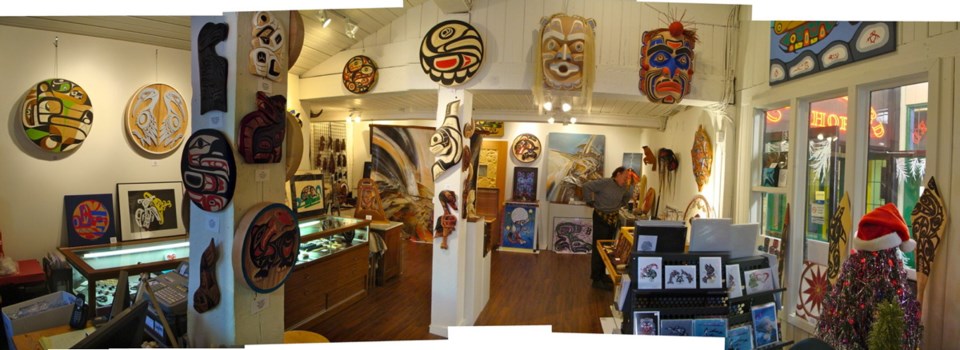 Eagle Feather First Nations Artists Gallery, 21a-633 Courtney St., 250-388-4330, eaglefeathergallery.com
Eagle Feather First Nations Artists Gallery, 21a-633 Courtney St., 250-388-4330, eaglefeathergallery.com
A few weeks ago, I noted that Eagle Feather Gallery had closed its Gordon Street location. But the gallery hadn’t gone away — just moved around the corner to Courtney Street. That’s good news for people who appreciate First Nations art.
I dropped in on owner Chris MacDonald in his cosy new gallery, and we talked about what makes Eagle Feather unique.
The gallery is set up to feature contemporary artists, most of whom live in Victoria, regardless of tribal affiliation. While retail business is always welcome, Eagle Feather has built its 15-year reputation as a conduit for commissions. Beginning with a client’s partially formed ideas, MacDonald contacts the appropriate artist and acts as an intermediary so all goes smoothly.
“In Japan, I worked in project-management work,” MacDonald said. “That experience lends itself to co-ordinating commissions.”
At that time, while living near Tokyo, MacDonald’s wife Shirley Blackstar reunited with her Cree family in Manitoba. She was inspired to create some economic development opportunities for her family by selling First Nations arts and crafts in Tokyo. Returning to Canada, Blackstar and MacDonald thought of developing an artists’ co-operative but, realizing that a co-operative was not practical, they took on the responsibility of a gallery.
A small number of artists call this gallery home — Tony Hunt Jr., Frances Dick, Ice Bear, Mervyn Child, silversmith Herb Lancaster and a few others have loyally provided their best work, dropping by every week or so. As the years went on, the artists involved their wives and children and wider family associates.
“A family unit working together on art work, that’s the key to success,” MacDonald said with a smile. “We’re fortunate to be part of the process. Credit all goes back to the artist at the end of the day.”
Kwak waka wak’w elder Doug LaFortune is “the back bone of the gallery,” MacDonald said. LaFortune’s wife Cathy is instrumental in finishing his carvings, and son Doug Horne Jr., an anthropology student at the University of Victoria, is coming into his own as a carver.
“It is the family that is the strength of the artist,” MacDonald said. LaFortune is at work on yet another commission arranged by Eagle Feather, this time a carving in wood, which will be cast in bronze locally by Nathan Scott, and installed in the new section of the Uptown Centre. For the opening of the original section, MacDonald oversaw a mosaic project, created by Joe Wilson and incorporating 4,000 pieces of Mexican glass.
Many people who visit the gallery start thinking about something special for their homes. Eagle Feather is in touch with craftsmen who can provide bent-corner boxes, custom doors or wooden panels for their artists to carve, as they did for a recent commission for the Saanich Peninsula Hospital. If modern technologies such as sand-blasting or glass-etching are required, the gallery knows who to call.
“We work with artists all up the Island,” MacDonald said. He noted a couple of large masks recently completed on commission for a Lake of the Woods lodge by Tony Hunt Jr., which required large pieces of cedar provided from contacts in Fort Rupert.
“What I love about the art is it’s an organic process,” MacDonald said. “From selecting the wood — which now takes more of the artist’s time and resources — to designing the piece, watching it take shape and sending photos to the client as it goes along.”
Art these days is the key to connecting First Nations and local communities. Most schools have had visiting artists, and there are First Peoples’ buildings at UVic and Camosun College. New curatorships for First Nations art are part of the Art Gallery of Greater Victoria and Open Space, and the Royal B.C. Museum is about to update its ethnology displays.
MacDonald was recently instrumental in bringing Tony Hunt Jr. to carve a totem at First Metropolitan Church, “right next to the pulpit,” he said. One Sunday, the minister said: “As we see progress in the totem each week, let us ask ourselves what progress we are making in our reconciliation with the First Nations.”
Eagle Feather has also taken local art to art fairs in France and, in September 2016, to Beijing. A Chinese gallerist invited them, selected the art work and bought most of it, to feature in her gallery there after the fair.
Frances Dick went with MacDonald. She has been with the gallery since the beginning, and works in many media, including acrylics on canvas, painted drums and carved doors. As MacDonald pointed out, she is “a great ambassador for the art, as an artist and presenter.”
Also well-received in China were the powerfully expressive acrylic paintings by the Ojibway man known as Ice Bear, one of which MacDonald had on display in the Courtney Street gallery.
From giftware to major corporate installations, Eagle Feather is in business to provide a point of access between clients and First Nations artists.
“The gallery’s focus has been on creating custom work for our clientele,” MacDonald said. “And that often means working with an artist whose work the client appreciates, and then working with the client to realize their vision for the piece.”
Long may Eagle Feather bring local artists together with clients from around the world.
